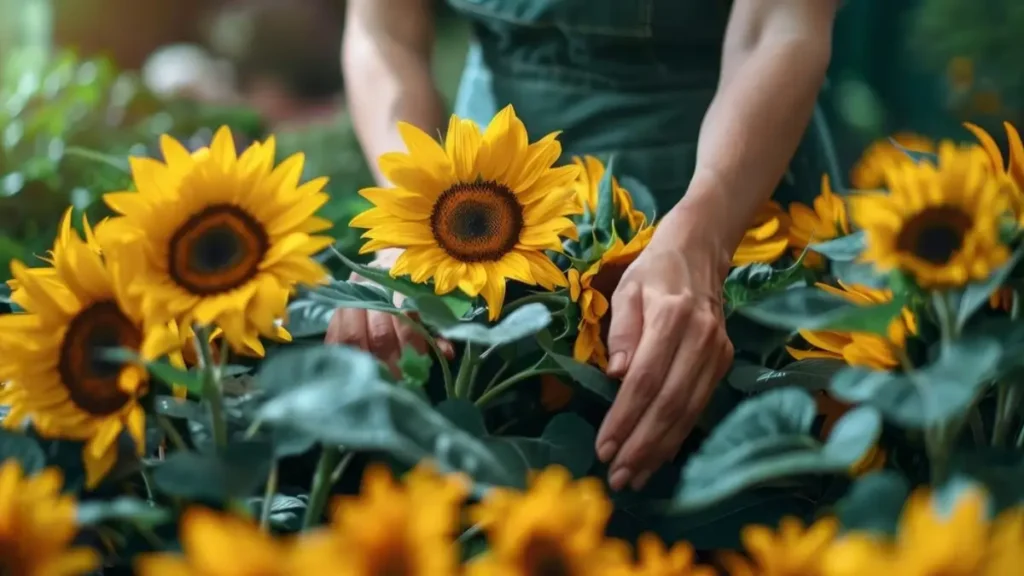Learning how to grow sunflowers can add a touch of sunshine to any garden. Sunflowers are a delight to grow as well as a pleasure to behold with their vivid colors and tall stalks. Growing sunflowers may be a gratifying and satisfying hobby for anyone, regardless of gardening expertise level. These happy flowers can flourish in gardens, on balconies, or even in pots indoors with the right maintenance, adding a little sunshine to any area. Join us on this trip as we discover how to grow sunflowers.
Here’s a detailed guide on how to grow sunflowers:
- Select a sunflower variety appropriate for the size and climate of your garden. Dwarf Sunspot, Lemon Queen, Velvet Queen, and Giant Russian are common types. When choosing seeds, take into account elements like bloom size, height, and color.
- Select a location in your garden that gets at least 6 to 8 hours of direct sunshine every day for sunflowers, as they love full sun.
- Sunflowers like their soil to have a pH of 6.0 to 7.5 and to be well-drained. To enhance fertility and drainage, till the soil to a depth of around two feet and supplement it with aged manure or compost before planting.
- Sunflower seeds can be started inside and then transferred, or they can be placed directly into the ground. If beginning indoors, plant seeds in biodegradable pots two to four weeks before the last anticipated date of frost. Wait until the risk of frost has passed and the soil has warmed to at least 55°F (13°C) before planting directly outside. Depending on the kind, plant seeds 6–12 inches apart and 1 inch deep.

How to grow sunflowers with proper care:
- During the germination stage, keep the soil moist but not waterlogged for seven to ten days. Sunflowers can withstand some drought after they are established, but they will need frequent watering when the weather gets dry. Mulch should be applied to the plant’s base to keep moisture in and keep weeds at bay.
- To keep tall sunflower types from tipping over in severe winds, they may need to be staked or supported. To support the stems as they grow, set up stakes or a trellis.
- Although sunflowers don’t require much fertilizer, planting time is a good time to give them a balanced fertilizer treatment. Steer clear of overfertilizing, since too much nitrogen can encourage lush foliage at the price of producing flowers.
- Keep a frequent eye out for common pests like caterpillars, snails, and aphids on sunflowers. To manage infestations, hand-pick pests or apply organic insecticidal soap. Rotate your crops and maintain good garden hygiene to stop the growth of soil-borne illnesses.
- Sunflowers mature between 70-100 days, with firm, plump seeds and yellow or brown flower heads. Harvest when heads are attached, dry upside down, and store seeds in cool, dry conditions for later use or eating.
Conclusion:
To summarize, mastering the art of how to grow sunflowers takes careful attention to a variety of aspects, including soil preparation, sunlight exposure, a watering schedule, and insect management. Gardeners may grow vivid sunflowers that enhance the beauty and happiness of any landscape by following the instructions provided in this handbook.
Certainly! If you’d like to learn more, please consider following our WhatsApp Channel: Harvest Gardening
A frequently asked questions:
Q1: How to grow sunflowers from seeds?
A1: Sunflower seeds should be planted in well-drained soil in a sunny location, watered frequently, and exposed to lots of sunlight for best growth.
Q2: When is the best time to plant sunflowers?
A2: Sunflowers grow best when planted in late spring or early summer, which is usually beyond your area’s last frost date.
Q3: How to grow sunflowers in a pot?
Q3: Sunflower seeds should be planted one inch deep in a large container with well-draining soil, and they should get at least six hours of sunlight each day to thrive in a pot.




2 Comments
Pingback: Flowers to Plant in August: Top 6 Blooms for a Stunning Garden
Pingback: Asteraceae:Discover 3 Unique Asteraceae Family Species Today